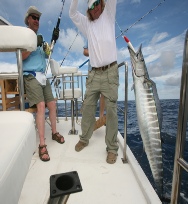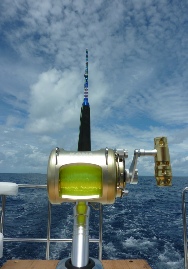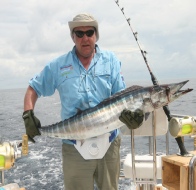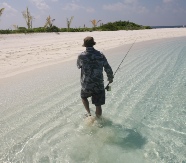© 2014 Gary Smith Fishing Ltd All Rights Reserved










Proudly Associated With


After describing previously the basics of shore angling in the Mediterranean it is probably the time to have a go - if you have not already done so.
One of the most shore angler friendly locations, especially for beginners has to be Isla Plana beach just outside Puerto De Mazarron, situated at the side of the coast road, the E22 to Cartagena. Directions from Puerto De Mazarron, travel towards Cartagena on the N332. After one kilometre the first junction you come to near the Repsol Garage is signposted Isla Plana. Turn right here and follow the road past the Oceanographic Centre on your right for 2 kilometres through Isla Plana village. As you come to the end of Isla Plana on your right will be La Charra Restaurant and on your left Calida Sol Villas, one hundred metres after these are a set of traffic light at a pedestrian crossing, you will see a sign on the wall pointing to the right saying Playa. Turn right, the sea will be a hundred metres in front of you. At the end of the wall turn left on to a track that runs along the top of the beach. It is a hard track and as long as you keep to it you should not have any problems. Continue along this track for five hundred metres until you come to the end of the streetlights. Park alongside the wall where it is wide enough for two vehicles. If you are travelling from Cartagena on the N332 1 kilometre before Puerto De Mazarron turn left at the Repsol Garage signposted Isla Plana and follow instructions as above.
The beauty of this location is that you are fishing twenty metres from your vehicle and when it is dark there is background lighting - a huge bonus if you have never fished in the dark before. For fifty metres either side of the last street light is a very clean sandy seabed, ideal for snag free fishing and there are fish here even though it is shallow for quite a distance out.
Remember as always when you venture off on a fishing trip to tell someone where you are going and a rough idea of when you will return. If you are new to the sport the basic items you need with you apart from obviously a rod and reel are: Fishing Licence. Extra Clothing (even though it is Southern Spain it can become very cold very quickly). Bait, maybe silly to mention but believe me I have arrived, set everything up and………..forgot the bait! Baiting Needle. Rod Rest. Seat, four or five hours is a long time to stand. Towel or Cloth for drying your hands and handling fish when removing the hook - beware some of the fish have dorsal fins with spikes that will penetrate your hand with ease. Disgorger, to get the hook out of the fish. Bucket, to keep your catch in fresh seawater. Basic Tackle Box containing spare hooks, swivels and line. A pair of Scissors. Mobile Phone if possible. Plenty of food and drink. Antiseptic Wipes to clean your hands before eating your food, you do not know where those worms have been. Basic First Aid Kit. Insect repellent if you are susceptible to bites.
With regard to the aforementioned fish with sharp spikes, there are several fish that are very dangerous and you must under no circumstances touch them. The most dangerous are the Arana (The Great Weever) the Cabracho (Large Scaled Scorpion Fish) and the Morena (Moray Eel). The Weever fish is usually from twenty to fifty centimetres in length and is very distinctive looking with eyes and mouth facing upwards. The spines are poisonous. The Large Scaled Scorpion Fish is distinctive by the fact that its head is proportionally very big to the body. It has forty-five large scales on the lateral line and is usually between twenty five to fifty centimetres in length. The spines again contain venom. The Moray Eel is long and snake like with shiny brownish black skin and large golden / yellow spots. It grows up to two metres in length and does not like being caught and becomes ferocious. Its bite can produce toxic symptoms. If you happen to catch any of these fish it is better to cut the line and dispatch them back into the sea with a stick or something similar. If you are unlucky enough to be stung or bitten seek medical attention immediately. I am not trying to frighten anyone with this information it is just better to know and be aware than not and find out the hard way. I would strongly recommend that anyone fishing invest in a picture guide of Mediterranean fish species. Handle all fish with care as many have rows of very sharp teeth as can be clearly seen in the photo of the Palomete I caught last week.
Copyright © Gary Smith & Luigi Mateos
Back
| Address |
| Contact Us |
